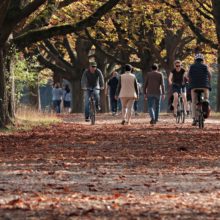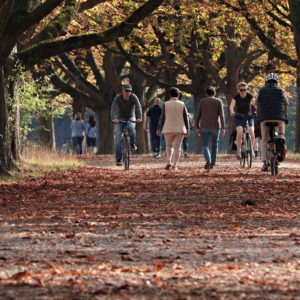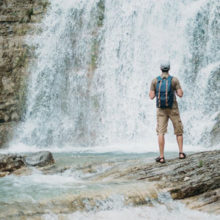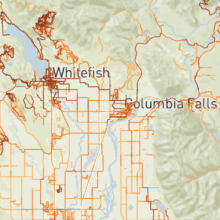Counties with outdoor recreation economies are more likely to attract new residents with greater wealth and have faster-growing wages than their non-recreation counterparts. These trends are particularly true in rural communities.
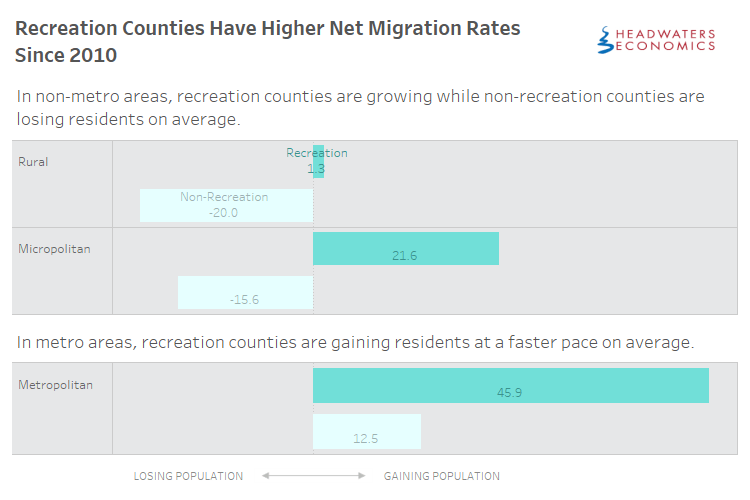
The National Conversation About Rural Economies Isn’t Optimistic
These findings come as the economic headwinds facing rural communities gain more attention nationally, including the concentration of jobs in big cities and increasing productivity (meaning lower employment per dollar of goods produced) of industries like manufacturing.
These changes have helped cause distressing economic trends for many rural communities: the loss of young people, fewer jobs in traditional sectors, and stagnant wages.
Much of the current writing about rural economies remains pessimistic about rural places and the political implications of increasing geographic inequality that is leaving many such communities behind. A recent op-ed in the New York Times even went so far as to suggest that the most effective strategy for people living in rural places might just be to make it easier for people in struggling rural places to move to booming cities.
Related Research
Analysis with methods, details and full paper (PDF)
Interactive map for every county in the country
Successful Strategies for Rural Prosperity
The reality, of course, is much more complex. Our work shows that rural communities are not all declining. Rural communities that have natural amenities and recreation economies do better. We also know from our frequent collaborator Dr. Julia Haggerty that communities that have crafted a vision of where they want to go and support strong local institutions are better able to adapt to change and capture new opportunities.
The authors of a recent Brookings Institute report propose strategies to distribute growth more broadly by building infrastructure (especially broadband), access to capital, and skills of people in more regions. The authors hypothesize that investing broadly in promising communities will help employers thrive in smaller cities and towns around the U.S., rather than just the large metros.
These findings offer ideas and policy options for rural leaders who work every day to make their communities better. But caution is also required to ensure the findings are not overstated and actions are appropriate for specific communities.
Subscribe to our newsletter!
Economic Development Strategies Must Reflect Communities’ Strengths
One necessary component is to pursue strategies that are geographically appropriate, reflecting each community’s proximity to capital, labor, and markets.
While an isolated community is unlikely to attract the new Amazon headquarters, geographically appropriate development strategies can capitalize on existing assets with strategies that take advantage of the historic, cultural, and natural resources that already exist in that region.
Outdoor recreation can be a component of a geographically appropriate economic development strategy. We have written extensively about the economic benefits of trails as part of a community’s recreation, transportation, and health infrastructure.
Many communities have demonstrated how trails can attract visitors, who spend money at local businesses, injecting money into the local economy. Research around the U.S. has found that trails also can increase property values and improve public health, particularly in low-income neighborhoods.
Outdoor Recreation Provides Economic Opportunity in Certain Communities
As researchers highlight the importance of recruiting and retaining skilled employees, the ability of recreation economies to attract new residents is a particularly powerful economic advantage.
Outdoor recreation economies often are equated with relatively low-paying service sector jobs. Results from this analysis show that average wages per job are, indeed, lower in recreation counties. This likely reflects the loss of sectors that traditionally sustained rural communities, including high-paying jobs in industries like manufacturing, mining, and oil and gas.
Encouragingly, our research found that recreation economies often can attract new residents with higher household income relative to people moving to non-recreation counties. Households moving to recreation counties also have higher incomes, on average, then people already living in the community. These new residents may be business owners, entrepreneurs, or retirees with nest eggs.

These relative newcomers may explain the faster growth in earnings per job, particularly in rural places. In other words, communities facing difficult economic transitions can catch up more quickly by leveraging their recreation opportunities.
Some rural places, like Emery County, Utah (which has historically been a coal mining community) are recognizing the potential for recreation to help even out the rise and fall of commodity-based economies, and are actively working to recruit new residents who move to the area for recreation.
Gallup, New Mexico sought to moderate the fluctuations of coal and uranium mining and decided to rebrand itself as the Adventure Capital of New Mexico, with an extensive trail system that brings mountain bikers and hikers to the community. The events connected to the trail system have brought millions in visitor spending into the area.
Creating a recreation economy is not for all communities and is not a simple replacement for lost jobs in traditional sectors. Efforts to develop a recreation destination must recognize first whether a community has the natural or cultural assets that could attract visitors and new residents.
A Recreation (or Any Other) Boom Brings New Challenges
Provided a community does have these resources, leaders must anticipate the challenges that accompany booming recreation towns, starting with rising cost of living and housing, changing land uses, and different stresses on infrastructure.
Communities must also consider how to build wealth in local institutions and local government and avoid becoming over reliant on seasonal and volatile employment. Fiscal policies that help retain wealth from extractive industries may provide lessons for recreation economies looking for ways to pay for these added stressors and costs associated with recreation, and to invest for growth in sector outside recreation.
Land use planning and meaningful affordable housing strategies also can ensure that these recreation communities remain appealing places to visit and live.
Diverse Opportunities for Diverse Rural Communities
National level conversations about rural places hopefully will be more frequent as 2020 presidential candidates court rural voters and need to consider the headwinds facing rural communities. These conversations also must understand the specific nuances and opportunities that exist across the diverse rural landscape.
Recreation is one strategy that can help many rural places bring in tourism dollars and attract residents who bring new wealth, ideas, and economic growth. Building these place-based strategies with the long-term fiscal and land use policies needed to manage growth can help rural communities find promising development approaches that work for them.

